Disclosure: Meeple Mountain received a free copy of this product in exchange for an honest, unbiased review. This review is not intended to be an endorsement.
We’ve all seen it before: a power line sagging under the weight of countless birds, each of them eyeing your newly washed car with (no doubt) evil intent. The moment you turn your back on them, you just know they’re going to take flight en masse and do their dirty work.
This behavior brings to mind many questions: Why me? Why my car specifically? How do they all sit up there without getting electrocuted? How many of them are even up there? And what are they even up there for in the first place?
The answer to that last question, as it turns out, is: racking up those sweet, sweet victory points.
Welcome to Perch: a game about flocks of birds wrestling for control of the choicest real estate on which to…well… perch.
Over the course of a game round, players are going to take turns placing the birds in their control onto the various locations dotted around the board. Each location rewards points based on a player’s position in the area control category. However, the game is tricky in that not every area rewards points the same. In one area, you might earn the most points if you’re in first place, whereas another area might score you the most points if you’re in third place. And, there are various creatures meandering about, that players can vie to control, which will remove birds from the board and send them to the fountain, from which the birds will never return. So, it’s essentially bird heaven. And there are loads of points to be earned from there as well.
After five rounds of play, a final scoring is performed to determine the winner.
Of course, this is a high-level overview of the game. If you think you’ve heard enough and just want to know what I think, feel free to skip ahead to the Thoughts section. Otherwise, read on as we learn how to play Perch.
Setup
A game of Perch is set up thusly:
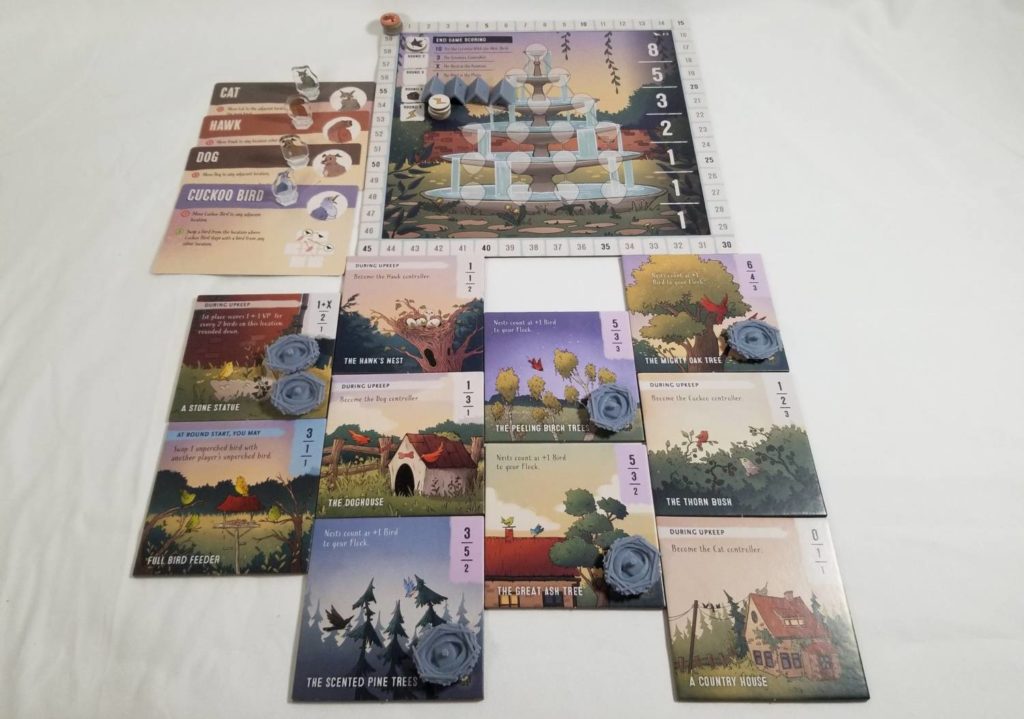
First, the Fountain board is placed into the center of the table. Then, a number of Location tiles are chosen, based on player count. The rule book recommends specific setups for each player count, but these can be randomly selected as well. There are three different types of Location tiles—Basic, Creatures, and Special—and there will always be some of each type required. The Location tiles are placed in a staggered formation next to the Fountain board. The Creature cards matching the selected Creature tiles are set aside along with the standees for each of the creatures. The Round marker is placed into the first position on the Fountain board. The drawstring bag is kept close at hand.
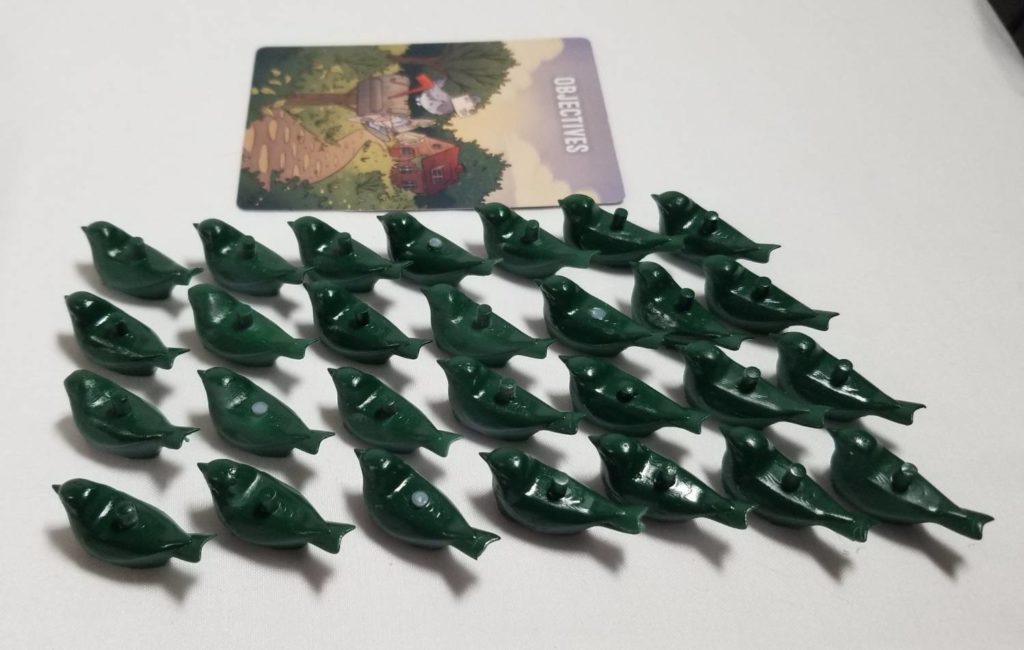
Next, each player chooses a color and takes into their possession all 28 birds of their selected color along with their Scoring token, a Birdhouse, and a Lightning token. The birdhouses are placed in a row next to the 4th Round space. Lightning tokens are placed in a stack to the right of the 5th Round space. The players’ Scoring tokens are placed onto the 0 of the score track. Each player also receives two cards drawn randomly from the Objective cards deck. They will select one of these cards to keep, returning the unselected card to the box.
Finally, a starting player is chosen and given the First player marker. Clockwise from this player, each other player receives the marker matching their number in the turn order. Then, you are ready to begin playing Perch.
A Round of Play
At the start of each round, every player adds two of their birds to the drawstring bag (migrating phase). Then, they take two of their birds from their supply and place them in front of them, the beginning of their soon-to-be-four-bird collection. After placing their birds into the bag, the bag is given a good shake and, beginning with the first player and then in turn order, the players take turns drawing two birds out of the bag and adding them to the two birds that were previously set aside (recruiting phase).
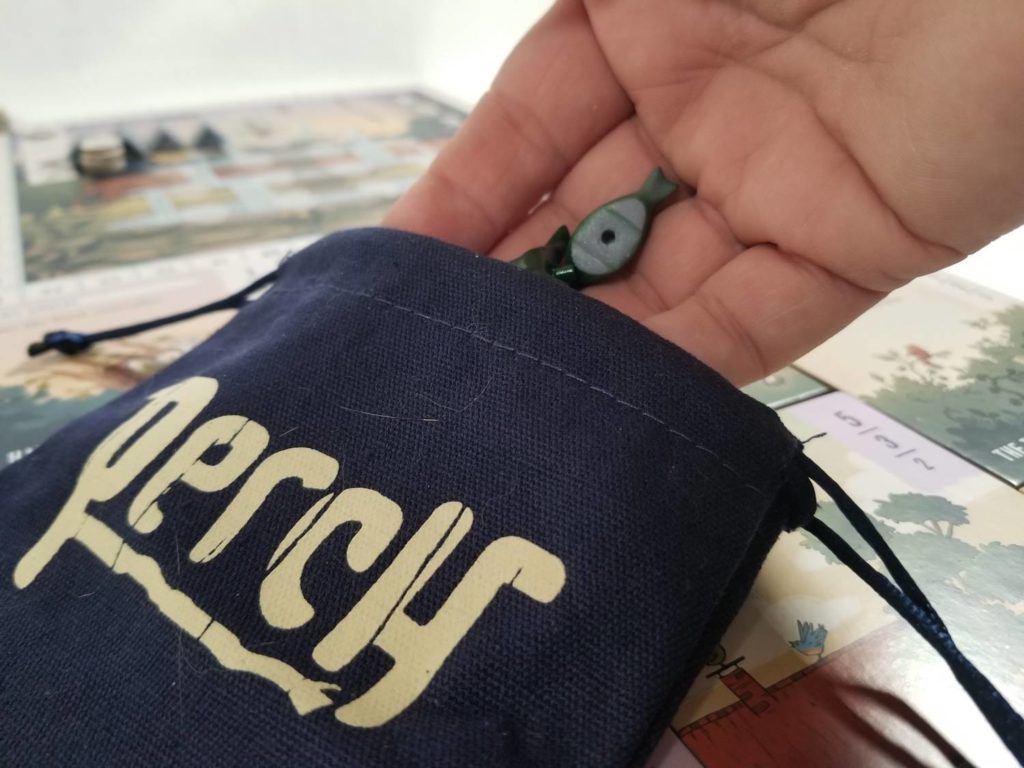
Once everyone has their four birds, the players take turns placing one bird at a time onto the Location tiles (perching phase) in turn order. After each player has taken a turn placing their first bird, the players take turns placing their second bird, then their third, and then their fourth. After the last player has placed their fourth bird, the round comes to an end and a scoring is performed. After scoring, there is an upkeep phase in which turn order tokens are redistributed—based on who has the highest score, the second highest score, etc.—and the Round marker is advanced. Birdhouses are released to the players at the start of the fourth round and Lightning tokens are released at the beginning of the sixth.
The Creatures, the Fountain, and Bonus Actions
Players may also gain (or lose) control of one or more of the creatures during the upkeep. The first time a creature enters the game, its standee is placed onto its matching tile and the player that gained control of it receives its card. From that point on, if a creature leaves the players’ control, its standee remains where it is and its card is returned to the supply until such time as someone gains control of its matching Location tile. The creature’s standee begins its time with its new controller from the position where it sits.
Before or after placing a bird, a player controlling a creature may move it and perform its action. This is one of several types of Bonus actions and only one Bonus action may be performed per bird placement.
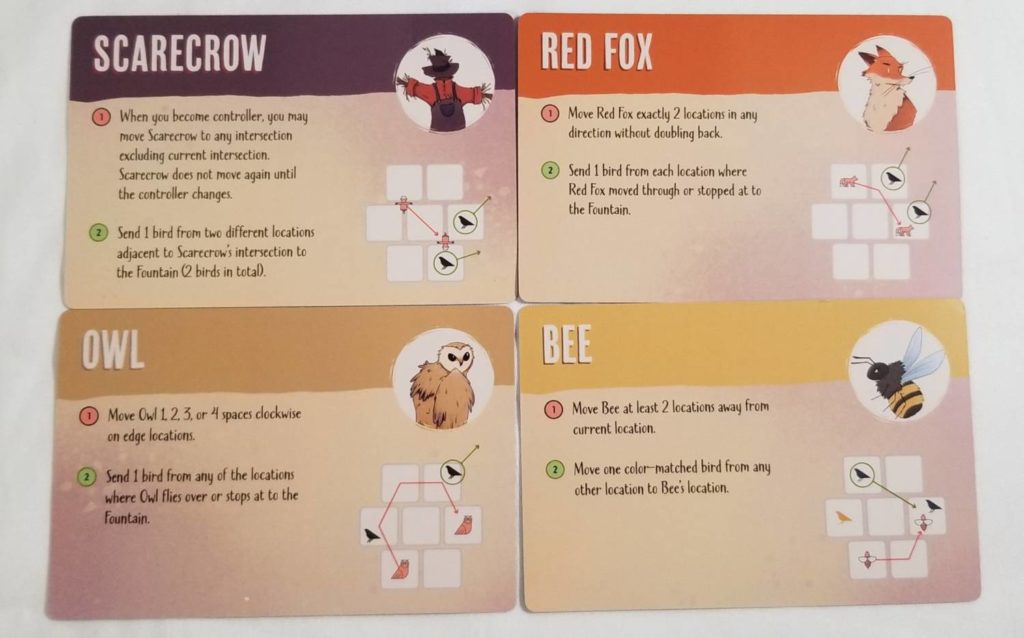
Each creature has two attributes: a specific pattern of movement and a special ability. These abilities all move birds around in some way. Some will cause birds to change locations from one Location tile to another. Others will chase birds away to the Fountain board, from whence they will never return.
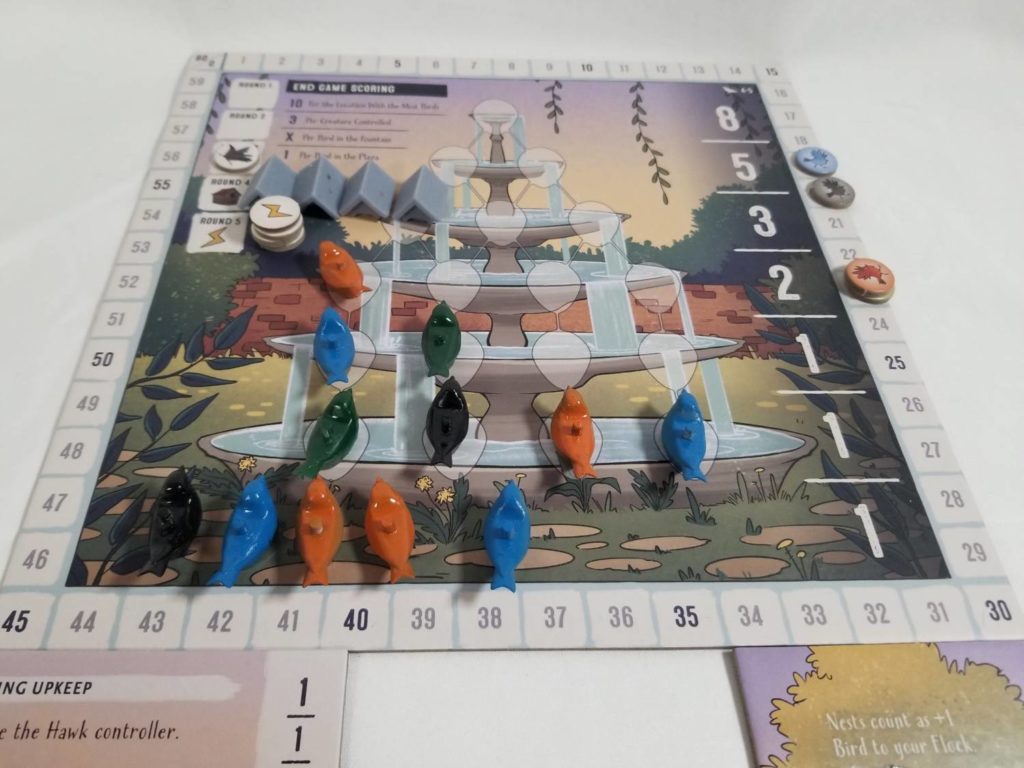
The titular Fountain is divided into several tiers, each supported by the tiers beneath it (similar to the end of the Research track in Lost Ruins of Arnak). Placing a bird into a new tier requires it to be supported by the tiers beneath it. Beneath the Fountain is an area referred to as the Plaza. Any number of birds can be placed into the Plaza without any restrictions.
The other two Bonus actions are placing a Birdhouse (more on this later) and using a Lightning token to remove a bird from play and send it directly to the Fountain.
Scoring
At the end of a round, each Location tile is assessed. The player with the most birds on a Location will score a certain number of points, as will second and third most. Each collection of players’ birds on a Location tile constitutes a flock. A flock assigned to a bird’s nest receives a +1 to its overall size during scoring. Birdhouses also add +1. Birdhouses are both a boon and a curse. Flocks protected by Birdhouses cannot be targeted by creatures or Lightning. However, once you’ve placed a Birdhouse onto a flock, that flock can never be added to (or removed from) for the remainder of the game.
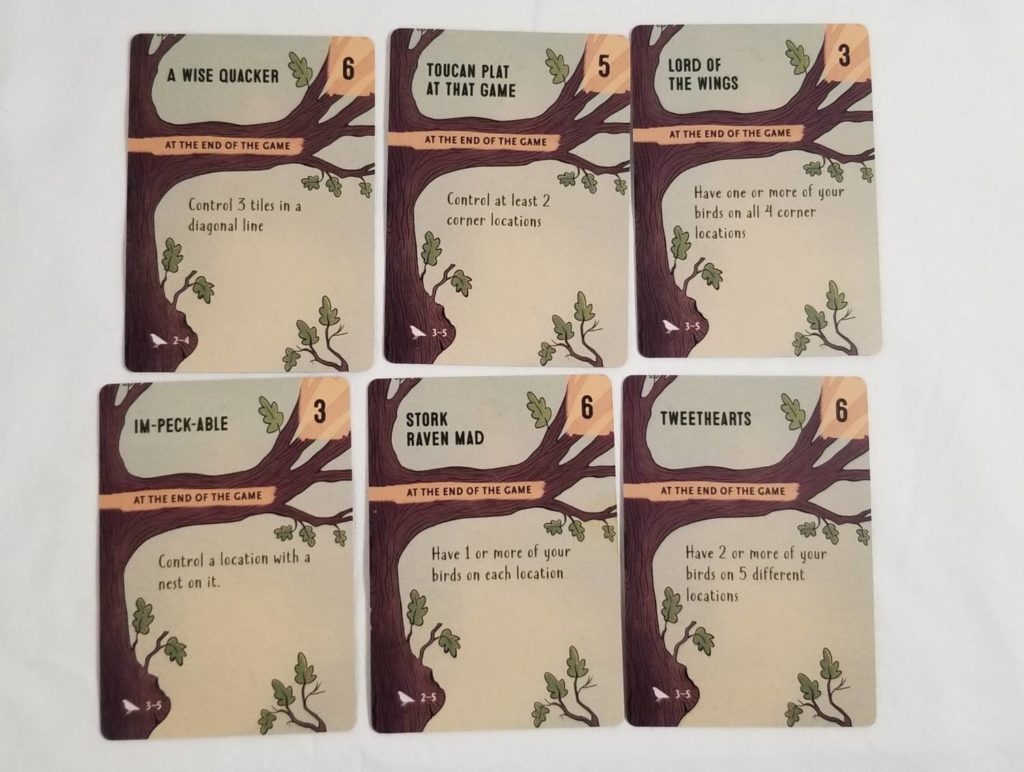
For all of that to make sense, it is important to understand that not every Location tile awards the greatest number of points to the player who has the most birds placed on it. Some will reward the most points to the player with the second or third most. And, ties in Perch are unfriendly. If two players tie for first, for instance, neither one of them will score any points, nobody will control the tile, and only the person in third place will score anything.
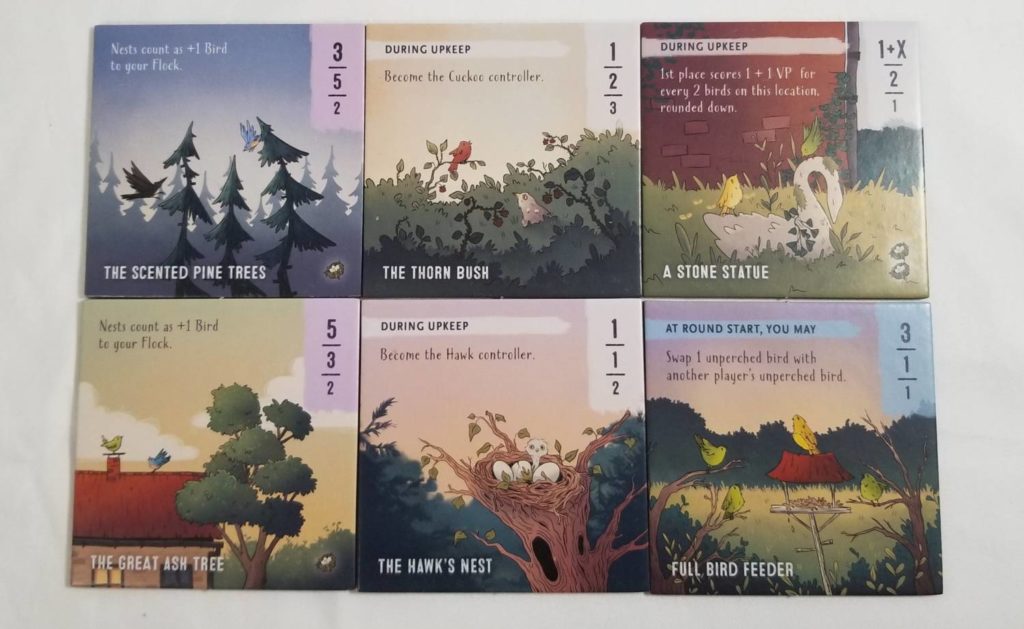
After scoring the fifth round, a final scoring is performed to determine the winner. Players score points based on who has the largest overall flock, the position of the players’ birds in the Fountain and Plaza, as well as points scored from completing their secret objectives.
Thoughts
Perch is a lovely game. Anna Block’s gorgeous illustrations lend a sense of placid calm to an otherwise tumultuous experience. Her usage of color puts one in mind of an early Spring sunrise or early dusk. You can almost imagine yourself sitting there, a warm mug of hot cocoa in hand, just basking in the beauty of the nature that surrounds you, unaware of the drama unfolding in the trees above.
Throughout the course of the game, there are a lot of interesting decisions to make. Perch bucks the trend of traditional area control games that reward players for having the most of a thing at a certain location, and this ingenious bit of game design is what really makes the game sing. It’s easy to vie for first place, but it’s an entirely different ball game trying to vie for last.
However, even that isn’t cut and dried. Invariably, the Location tiles that score the most points for being in last place are the tiles that also have the strongest abilities for being in first. So, there’s a fine balance that players will have to strike between scoring points and having access to a Location’s ability.
And, just to make things even more interesting, due to the way birds are drawn from the bag, you’re not just placing your own birds. You’re placing your opponents’ birds as well. That presents its own problems. Your first impulse will be to place their birds where they’ll change the board state the least. But, if you’re clever enough, you can place their birds in such a way as to benefit yourself. Want to be in second place on a Location tile so you’ll earn the most points during scoring? Stack your opponents’ birds on the spot to ensure they’ll always be in first. But, getting the timing right is crucial. If your opponents catch on to what you’re doing, they may retaliate by stacking your own birds onto the space, thereby ensuring you’ll be in first place and they will be in second when scoring comes around. But maybe that was your plan all along. Maybe you just want them to think you’re after the points when what you’re really after is the Location’s ability.
It’s a tricky game filled to the brim with a lot of guessing and second guessing, using the limited information presented to you to make the best decisions possible. These are all aspects of games that I typically enjoy.
But, despite all of that, I’m just not a fan.
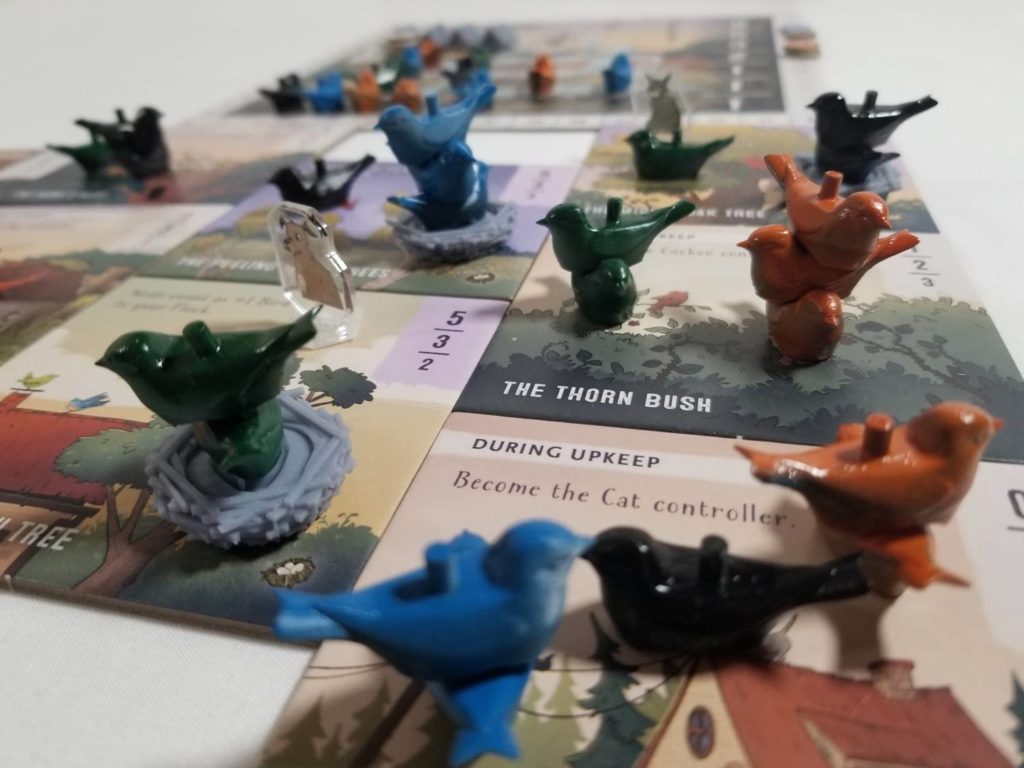
It isn’t that Perch is a bad game. It’s not. It’s a well-designed game with a lot of promise. But it just feels like it never quite delivers on that promise.
This is one of those moments where being a review writer becomes difficult. Sometimes it’s easy to talk about why a game doesn’t sit well with you: poorly written rules, nonsensical or uninteresting gameplay, terrible artwork, troubling thematic issues, etc. Perch is different. It’s hard to put my finger on any specific thing other than to say that playing Perch just never leaves me feeling fulfilled.
I know what you’re thinking: what does that even mean? The easiest way to describe the way that Perch leaves me feeling is to repeat something from my review of Inside Up Games’s previous offering, Terminus. In that review, I wrote of playing Terminus: “When you walk away from the experience, you’ll find yourself overanalyzing every move you made, trying to figure out where you went wrong or how you could have done better. And that just leaves you longing for more.”
That’s what I want from a game. Perch doesn’t leave me feeling that way. After one session with Perch, the only reason I felt compelled to play it again at all was because I felt that I had a duty to so that I could write a fair review of it. Now, five or six games later at various player counts, I don’t feel any differently.
Maybe you’re different. Maybe Perch is the perfect fit for you. If you wind up picking it up, I hope you have a great time with it. As for me, I’ll just be down here washing my car…again.


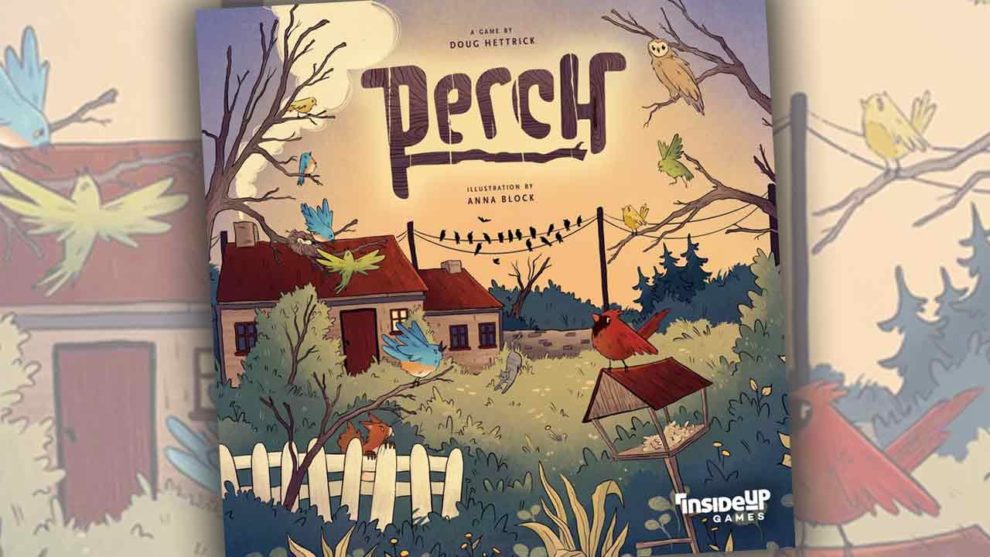








Add Comment